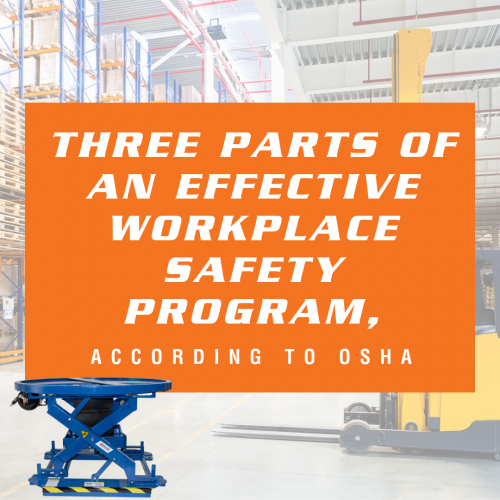We use cookies to make your experience better. To comply with the new e-Privacy directive, we need to ask for your consent to set the cookies. Learn more.
Three Parts of an Effective Workplace Safety Program, According to OSHA

How effective is your existing workplace safety program?
According to statistics from the Occupational Safety and Health Administration, U.S. businesses are headed in the right direction. The incidence rate of workplace injuries and illnesses was 10.9 per 100 in 1972; by 2017, it had plummeted to 2.8 per 100 workers.
In 1970, 38 workers lost their lives to occupational hazards every day. By 2017, we were down to 14 fatalities per day, across the country. That good news, however, is also bad news. In 2017, more than 5,000 Americans lost their lives at work. In other words, there’s still plenty of room for improvement.
As we get close to OSHA’s Safe & Sound Week, which calls on employers to reimagine workplace safety all year round, let’s get back to basics. What are the basic building blocks of a strong workplace safety program?
According to OSHA, we can boil them down to just three fundamental elements:
-
Management’s Role: Strong Leadership
Safe workplaces start at the top. Managers must take the lead on the development and implementation of safety protocols — but they must also model safe behaviors to build a culture of safety that extends across the company.
In addition to planning and introducing safety programs, company leadership will be responsible for providing resources and protective equipment to employees. Positive reinforcement can also improve participation. Consider rewarding staff for outstanding contributions to the safe workplace.
-
The Employee’s Role: Consistent Participation
No one knows more about frontline safety hazards than your frontline staff. Include workers at every step of the process, inviting them into program design and establishing clear, accessible lines of communication for reporting injuries or existing hazards.
Training is a big part of worker participation in creating a safer workplace. Even with a fully trained staff, however, workers should feel empowered to share new ideas and report unsafe working conditions at any time.
-
The Process: A Hazard Discovery and Elimination Program
The purpose of a workplace safety program is to remove hazards. The first step in this task, then, is hazard identification. Create a systematic approach to spotting hazards, reporting them, and, ultimately, removing them from the workplace.
The OSHA Hierarchy of Controls can help with hazard removal. According to this inverted-pyramid model, the most effective way to remove a hazard is to...eliminate the hazard. If employees are reaching and bending to work with pallets, for instance, remove that ergonomic risk by installing Pallet Carousel & Skid Positioners, which adjust to keep pallet work within the worker’s ergonomic range of motion.
The idea behind OSHA’s Safe & Sound program (which culminates in the yearly Safe & Sound Week events) is that regulation and enforcement aren’t enough to eliminate workplace injury entirely. After all, OSHA is a tiny agency when measured against the scale of the entire U.S. workforce.
The Administration only employs 2,100 inspectors, with a budget of less than $600 million (of the Department of Labor’s total expected 2020 budget of nearly $40 billion). In other words, OSHA can’t effectively reduce workplace injuries without the participation of every employer.
Instead, then, through the Administration’s Safe & Sound initiative, OSHA provides resources for employers to improve safety voluntarily, through in-house safety programs. To learn more about Safe & Sound, and to participate in Safe & Sound Week, which runs August 12 through 18, 2019, visit OSHA’s website here.
References:
“Commonly Used Statistics.” OSHA. Occupational Safety and Health Administration, U.S. Department of Labor, n.d. Web. 18 Jul. 2019.
“Safe & Sound.” OSHA. Occupational Safety and Health Administration, U.S. Department of Labor, n.d. Web. 18 Jul. 2019.
“Safety & Health Programs.” OSHA. Occupational Safety and Health Administration, U.S. Department of Labor, n.d. Web. 18 Jul. 2019.
